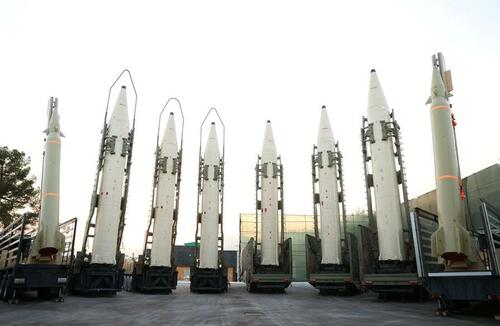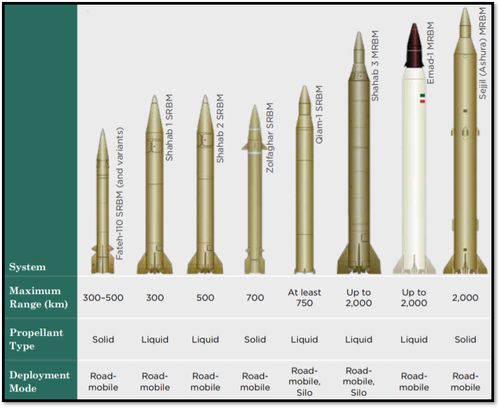Amid UN snapback sanctions targeting Tehran, Europe has also been calling for Iran to curb its missile program, but obviously the country just came under unprovoked Israeli and US attack last June, and launched dozens or possibly hundreds of ballistic missiles on Tel Aviv and other locations in Israel.
"Our missiles will reach the range that they need to," a military official on behalf the elite Islamic Revolutionary Guard Corps (IRGC) has responded, according to Fars news agency.
Deputy commander of the Khatam al-Anbiya Central Military Headquarters, Mohammad Jafar Asadi, indicated Wednesday said Tehran would increase the range of its missiles "to wherever necessary" in order to do whatever it takes to defend the country.
He described further that "with the resources we have, we are 100% ready; however we will not be the first to start a war, but if anyone invades our country we will respond decisively."

And in particular he responded to European demands to place more limits on the range of its missile arsenal by saying, "I can only say they were wrong" to issue such demands.
Mideast analysts have recently speculated that Israel could be preparing for another attack on Iranian missile and nuclear sites, though Netanyahu is unlikely to want to anger Trump, or engage in any new strikes without his approval. Trump has hailed his 'truce' deal which ended the 12-day June war, and probably doesn't want to jeopardize it.
It's widely believed that Iranian missiles have a maximum range of 2,000 km, which covers the distance to Israel - Iran's number one foe - but the Iranians are hinting at increasing this range. For example, missiles launched from the eastern half of the country, which are more protected from Israeli attacks, would of necessity be extended in range.
A recent missile tests suggests that the Iranians are indeed moving forward with extending the ranges of their missiles, as the Washington think tank FDD observes:
Late last week, Iranians took to social media to post pictures and video of what appeared to be the plume, or the high-temperature exhaust gases, of a ballistic missile in flight. The unpublicized nature of the launch by Iranian authorities, coupled with various images of the projectile’s odd trajectory, led to a guessing game as to whether the test failed and what kind of projectile was deployed. Was this an older missile with a poor flight-test track record, a newer missile with a different warhead, a space-launch vehicle (SLV), or, as one parliamentarian alleged, an intercontinental ballistic missile (ICBM)?
More recent open-source analysis indicates that the launch was an SLV test from a known space launch pad in Semnan province, while the projectile’s white plume points to the use of solid-propellant, a type of fuel for missiles that Israel targeted in the past due to its military utility.
Several angles of the projectile’s flight path, coupled with images of small bursts of smoke seen dotting the sky, hint at a technical malfunction, namely combustion issues. But even a failed test provides Tehran with information about the performance and reliability of its projectiles, while also signaling a continued interest in growing its missile program following the 12-Day War with Israel.
Like Israel, the Islamic Republic is seeking to rapidly replace the firepower it lost due to missile exchanges with Israel this past summer. FDD continues:
Beyond serving as the delivery vehicle for a potential nuclear weapon, Iran’s ballistic missiles play a key role in the Islamic Republic’s defense and security strategy, enabling it to deter and coerce adversaries. According to U.S. intelligence estimates, Tehran has long been home to the largest arsenal of ballistic missiles in the Middle East, most of which are road-mobile and stored in underground bunkers dispersed across Iran. Prior to the 12-Day War, Iran possessed an arsenal of roughly 2,500-3,000 ballistic missiles of various ranges and propellant types, as well as around 300-400 transporter erector launchers (TELs) used to move and fire these weapons.
After the war, Iran’s launchers and missiles were cut by roughly half, with a TEL count now estimated at 150-200, and an overall ballistic missile stockpile of about 1,300-1,500. Recent reports indicate that Iran is undertaking a sustained effort to restore its ballistic missile production facilities that Israel destroyed.

The Europeans led the way to impose snapback sanctions on Iran last week related to its nuclear program, leaving Tehran outraged, and so at this point it has little incentive to conform to Western demands. Instead it has every reason to want to bulk up its missile program, for the next potential round of fighting with Israel, amid continued tensions.
Meanwhile, US Treasury Secretary Bessent says that Treasury is targeting "Iranian weapons procurement networks that help maintain its ballistic missile and military aircraft program" in new punitive US action.
Loading recommendations...